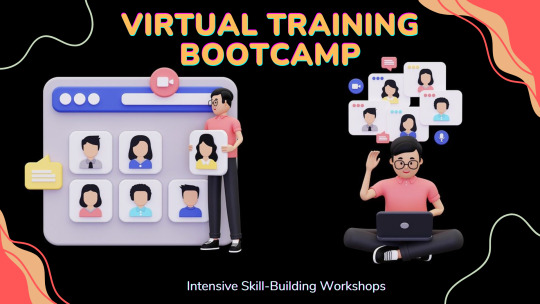#remote employee
Explore tagged Tumblr posts
Text
Remote Employee Training Strategies For Success

In today’s fast-evolving business landscape, the shift towards remote work has become a prominent trend. With this shift, companies are faced with the challenge of maintaining high standards of performance, engagement, and productivity among their remote teams. A crucial part of this is employee training. Effective remote training programs are essential for ensuring that employees are equipped with the skills and knowledge they need to succeed, no matter where they are working from. In this article, we’ll explore several strategies for successful Virtual employee training.
#1 Develop Clear and Structured Training Programs
One of the first steps to ensuring a successful training experience for remote employee is to create a clear and structured program. Unlike in-person training, where employees can ask questions or get immediate feedback, remote training often happens asynchronously. Your training materials should be organized, easy to follow, and concise to make this process as effective as possible.
Break down complex information into manageable modules, use visual aids, and incorporate interactive elements to keep employees engaged. A well-structured training program allows Virtual employees to progress at their own pace while ensuring that the content is comprehensive and easy to understand.
#2 Leverage Technology to Enhance Learning

Technology is the backbone of remote work and plays a crucial role in Virtual employee training. Using the right tools can make a significant difference in how employees interact with training materials. Video conferencing platforms like Zoom or Microsoft Teams are essential for live training sessions, allowing employees to participate in real-time discussions, ask questions, and receive immediate feedback.
Additionally, learning management systems (LMS) like Moodle or TalentLMS can help organize and track training content. These systems allow for self-paced learning, quizzes, and certifications. Incorporating multimedia elements such as video tutorials, infographics, and interactive simulations can also help employees retain the information better and keep them engaged throughout the training process.
#3 Foster a Culture of Continuous Learning
Virtual training should not be a one-off event; it must be an ongoing process. Virtual employees often face the challenge of isolation and may miss out on spontaneous learning opportunities that arise in a traditional office setting. Therefore, it’s important to create a culture that encourages continuous learning.
This can be achieved by providing regular learning resources, encouraging employees to pursue online courses, and organizing regular webinars or knowledge-sharing sessions. Incentivizing employees to learn new skills, such as offering certifications or rewards for completing training, can also drive engagement and improve long-term retention of knowledge.
#4 Provide Personalized Learning Paths

Not all employees learn in the same way or at the same pace. A one-size-fits-all approach to training can lead to disengagement or frustration, especially for employees who might already have expertise in certain areas. Personalizing the learning experience is an effective way to meet the individual needs of each employee.
Assess the current skill levels of your remote team members and tailor training programs to match their specific learning requirements. For example, some employees may need more foundational training, while others may benefit from advanced modules. Personalized learning paths also allow employees to focus on areas where they need the most improvement, ultimately leading to more efficient skill development.
#5 Prioritize Communication and Feedback
Clear communication is essential in any training program, but it becomes even more important when working remotely. Regular feedback helps ensure that Remote team members stay on track and feel supported throughout the training process. Incorporate opportunities for real-time feedback through virtual check-ins, one-on-one meetings, and surveys.
Be proactive in providing employee feedback on performance and areas for improvement, while also being open to suggestions on how the training can be improved. Encourage employees to ask questions and seek clarification when needed. This two-way communication helps build trust and enhances the overall effectiveness of the training program.
#6 Create an Engaging and Collaborative Environment

Training doesn’t have to be a solitary experience, even for remote teams. Encourage collaboration among employees during the training process. This can be achieved through group activities, peer learning, or discussion forums where employees can share insights, challenges, and best practices. Platforms like Slack or Microsoft Teams can be used for team discussions, brainstorming sessions, and informal learning.
A sense of community is vital for remote workers, and fostering this environment during training helps employees feel more connected to their colleagues and the company. In turn, this engagement increases the likelihood of successful knowledge retention and application.
#7 Measure Training Effectiveness
Once your Remote team member training program is in place, it’s important to regularly assess its effectiveness. Use analytics to track employee progress, completion rates, and quiz results. Collect feedback from employees about their learning experiences and identify areas where the training can be improved.
Monitoring training effectiveness helps ensure that your efforts are paying off and that employees are gaining the necessary skills to succeed. Continuous evaluation also helps you stay updated with new training tools or methodologies that can enhance the learning experience.
You can also watch: EmpMonitor: Manage Remote Work Easily
youtube
Conclusion
As remote work continues to shape the future of business, developing effective training strategies for remote teams is more important than ever. By creating structured training programs, leveraging technology, fostering continuous learning, personalizing learning paths, and encouraging collaboration, companies can set their remote employee up for success. When done right, Remote team member training not only enhances individual performance but also drives overall business growth.
#remote employee#remote team management#remote work management#Virtual team member#Virtual worker#Youtube
2 notes
·
View notes
Text
Virtual Training Bootcamp: Intensive Skill-Building Workshops

Imagine a learning experience that doesn’t just teach you new skills but transforms how you think, work, and grow. Welcome to the Virtual Training Bootcamp, where innovation meets intensive learning. Whether you're gearing up for a career leap, fine-tuning your expertise, or tackling new challenges head-on, this boot camp is designed to help you thrive in today’s competitive world. Combining expert-led sessions with dynamic, interactive technologies, provides a unique opportunity to obtain real-world knowledge in an engaging and adaptable format.
If you're ready to elevate your abilities to the next level, this is the game-changer you've been looking for.
Why Choose a Virtual Training Bootcamp?
Gone are the days when professional development required rigid schedules or expensive travel. Virtual bootcamps bring the classroom to you, offering unmatched convenience without compromising quality. Here's what sets them apart:
Comprehensive and Specialized Modules
These boot camps focus on delivering a hands-on experience, breaking down complex topics into digestible modules. Each session is led by seasoned instructors who combine theoretical insights with practical exercises, ensuring a 360-degree understanding of their chosen subject.
Interactive Learning Experience

Engagement is the cornerstone of effective learning. These training bootcamps leverage cutting-edge tools like live Q&A, real-time polls, breakout rooms, and gamified challenges to keep participants involved and motivated.
Adaptable Learning Paths
Whether you're a beginner or an experienced professional, virtual bootcamps are designed to cater to varying skill levels. Participants can choose foundational workshops or advanced courses, making it a perfect fit for diverse learning needs.
Networking Opportunities
These programs bring together individuals from different industries and locations, fostering collaboration and networking. By connecting with like-minded peers and industry leaders, participants often gain valuable insights and opportunities beyond the training.
Key Features of a Virtual Training Bootcamp

To truly understand the value of these workshops, let’s explore some of their defining features:
Expert Instructors: Learn directly from industry veterans with proven track records in their fields.
Real-World Scenarios: Apply concepts through case studies, simulations, and project-based learning.
Flexible Scheduling: With options for weekend or evening sessions, these boot camps accommodate even the busiest schedules.
Post-Bootcamp Support: Many programs offer resources like recorded sessions, eBooks, and mentorship opportunities to support ongoing learning.
Who Can Benefit?
The charm of these training bootcamps stems from its broad appeal. Whether you’re an individual aiming for personal growth or a corporation seeking to upskill your workforce planning, these workshops offer something for everyone:
Professionals: Gain new certifications, enhance your resume, or prepare for career advancement.
Entrepreneurs: Master skills like digital marketing, financial management, or product design to grow your business.
Corporates: Empower your team with training that drives productivity, innovation, and efficiency.
Popular Workshop Topics

These training bootcamps cover a wide array of topics, ensuring there’s something for everyone. Some of the most in-demand areas include:
Data Analytics: To make wise decisions, learn to gather, examine, and understand data.
Digital Marketing: Develop your social media, content marketing, and SEO skills to improve your brand.
Leadership Skills: Develop the emotional intelligence, communication skills, and strategic thinking required to lead teams effectively.
Tech Tools: Get hands-on experience with popular software like Excel, Python, and visual project management tools.
How to Make the Most of a Virtual Training Bootcamp
To fully benefit from these workshops, participants should approach them with a clear strategy:
Set Clear Goals: Define what you want to accomplish by the end of the program.
Stay Engaged: Actively participate in live sessions and complete all assignments.
Leverage Resources: Use supplementary materials like guides, forums, and mentorship programs to deepen your understanding.
Apply Your Knowledge: Practice your newly acquired skills in real-world scenarios as soon as possible.
Also, watch this video - EmpMonitor(Employee Monitoring Software) Dashboard & Its Features
youtube
Final Thoughts
Virtual learning Bootcamps are revolutionizing how we learn, providing a flexible yet powerful platform to acquire critical skills. These workshops not only save time and resources but also offer unparalleled opportunities to grow, connect, and excel in your field. If you’re ready to elevate your skills and stay ahead in your industry, this is your sign to enroll in a boot camp today. With the right virtual training software, these sessions will empower you to unlock your potential and achieve your professional dreams.
0 notes
Text
Boost Productivity & Transparency: Top Remote Employee Time Tracking Tools

As remote work becomes increasingly common, especially in light of recent global events, businesses need efficient methods to track employee productivity and ensure accurate payroll processing. Remote time tracking involves various tools and techniques designed to monitor employee work hours, track tasks and projects, and maintain transparency and accountability in remote work arrangements.
One of the primary methods of remote employee time tracking is through the use of time tracking software and applications. These tools allow employees to log their work hours, record time spent on specific tasks or projects, and track breaks and non-productive activities.
Managers can access these records in real-time to monitor employee productivity, identify bottlenecks, and provide feedback or support as needed. Additionally, time tracking software often integrates with project management tools, enabling seamless coordination and collaboration among remote teams.
Another common approach to tracking remote workers tool is through the use of biometric or digital time clocks. These devices, which may include fingerprint scanners or facial recognition technology, allow employees to clock in and out remotely, providing an accurate record of their work hours. This method helps prevent time theft and ensures that employees are paid fairly for the time they work.
Tips Or Tricks For Optimizing Remote Time Tracking Efficiency
Set Clear Goals And Priorities: Start your day by outlining specific goals and priorities. Break down larger projects into smaller, actionable tasks. Prioritize tasks based on deadlines, importance, and impact. Tools like time tracking for remote workers or project management software can help you organize and prioritize your workload effectively.
Use Time Tracking Tools: Explore various remote workers time tracking options available to find one that best suits your needs. Look for features such as automatic time tracking, customizable project tracking, and integration with other productivity tools. Experiment with different tools to find the one that fits seamlessly into your workflow. Establish A Routine: Create a daily routine that aligns with your natural energy levels and peak productivity times. Designate specific work hours and stick to them consistently. Incorporate regular breaks to avoid burnout and maintain focus throughout the day.

Minimize Distractions: Identify common distractions in your work environment and take steps to minimize them. This may involve setting boundaries with family members or roommates, using website blockers to limit access to distracting sites, or designating a dedicated workspace free from distractions.
Time Blocking: Allocate dedicated time blocks for different tasks or projects throughout your day. Use tools like calendars or planners to schedule time for focused work, meetings, breaks, and personal activities. Be realistic about the time needed for each task and adjust your schedule as needed.
Top 3 Remote Worker Time Tracker
Toggl
Toggl is a popular time tracking for remote employees known for its simplicity and user-friendly interface. It offers features like one-click timers, customizable project tracking, and detailed reporting. Toggl also integrates with various project management and productivity tools, making it easy to track time across different tasks and projects. It's suitable for freelancers, remote workers, and teams of all sizes.
EmpMonitor
The EmpMonitor is a comprehensive employee monitoring and time tracking software designed for remote teams. In addition to tracking time spent on tasks and projects, EmpMonitor offers advanced features such as keystroke logging, website and application tracking, screenshot capture, and activity monitoring.
It provides detailed insights into employee productivity, allowing managers to identify inefficiencies, optimize workflows, and ensure compliance with company policies. EmpMonitor is suitable for businesses that require advanced monitoring and time tracking capabilities for remote teams.
Clockify
Clockify is a free remote workforce management software with robust features for remote workers and teams. It offers unlimited users and projects, allowing you to track time spent on tasks, projects, and clients. Clockify offers browser extensions, desktop apps, and mobile apps for seamless time tracking across devices. It also provides detailed reports and insights to analyze productivity and billable hours. Also Watch: Leading Employee Engagement and Workforce Productivity Tool
youtube
Epilogue!
In conclusion, remote employee time tracking stands as a pivotal aspect of modern work dynamics, especially in the context of the increasingly prevalent remote work environment. As organizations transition to distributed workforces, the need for efficient and accurate methods of monitoring employee productivity and managing work hours becomes ever more crucial.
Through the utilization of advanced time tracking tools and techniques, businesses can effectively navigate the challenges of remote work and ensure optimal performance and accountability among their remote employees.
1 note
·
View note
Text
0 notes
Text
https://www.graystonetx.com/blog/risk-management-demystifying-workers-comp-for-remote-employees
0 notes
Text
Work at Home Job Opportunities
Work from Home Job Opportunities: Exploring the Benefits and Challenges The concept of working from home has become increasingly popular in recent years, thanks to technological advancements that have made it possible to work remotely. The COVID-19 pandemic also accelerated this trend, with many companies adopting work-from-home policies to keep their employees safe. This has led to a surge in…

View On WordPress
#Cloud commuting#Content Creator#Customer Service Representative#Digital nomad#Freelance#Freelance Writer#Graphic Designer#Home office#Home-based job#Independent contractor#Internet-based job#Mobile workforce#Online freelancer#Online job#Online Tutor#Remote employee#Remote position#Remote work#Telecommute-friendly#Telecommuting#Telework#Teleworking#Transcriptionist#virtual assistant#Virtual job#Web Developer#Work at Home Job Opportunities#work from home#Work from home job opportunity
1 note
·
View note
Text
The Khan’s are just PHENOMENAL. They’re so warm and vibrant and hysterical in all the best ways. The MCU is absent/shitty/dead/evil-parent-and-complicated-family central, theres too much familial feuding at times, whether that family is blood or adopted or found, so I am LIVING for and LOVING how the Khan’s are just so normal and ordinary and wonderful. It’s no wonder Kamala has such a can-do, confident, positive attitude. It’s no wonder she’s such a dreamer and proudly herself and so damn funny when she’s surrounded by so much love and encouragement. Kamala Khan and the fam need to be in more Marvel movies, their dynamic is just joyous and healing and I will NOT tolerate another Aunt May incident. I WILL NOT. I swear if anything happens to ANY of them-
#so I just watched the marvels#I adore the khans sm#they’re just JOY okay?#Like the Mr Khan talking to the 300 yr old SWORD employee about his retireement plan? I fuckin howled#Mrs Khan being like “THIS WOULD BE A LOVELY HOME FOR GRANDCHILDREN AAMIR’ while Aamir tries to mute her with a tv remote#how they ALL insist to GO TO SPACE to make sure Kamala is okay#I forgot how dearly I loved the Khans for a second#Kamala can get away with all sorts of chaos and mischief but as long as she safe they’re chill about it#I swear if they pull a Thor on Kamala I will FLIP#Kamala is gonna have to have a character growth arc with all of the Khans safe and sound#there was obvs so much more about the marvels that was great but I haven’t seen any posts appreciating the Khans#THE KHAN FAMILY I LOVE YOU#the marvels#ms marvel#kamala khan#the khans#miss marvel#the Khan family#carol danvers#captain Marvel#monica rambeau#mwah.txt#marvel#marvel cinematic universe#mcu
174 notes
·
View notes
Text
Biden trying to protect people, even on his way out!
#federal employees#work remote#work from home#joe biden#biden#biden administration#president biden#democrats#politics#donald trump#project 2025#elon musk#right wing extremism#right wing terrorism#right wing politics#right wing bullshit
39 notes
·
View notes
Text
"the factory down just past the end of my street exploded last night and we're under a shelter in place order so i can't leave my house also the trains aren't running" is now my wildest reason for calling out of work.
#everyone is OK all employees were safely evacuated and the fire didn't spread to surrounding houses#but it was pretty scary#probably i could have asked to work remote but i wouldn't have been focused#the vibes are WEIRD#it's still smoldering too so it's kind of loud here#with all the news helicopters and emergency services vehicles
11 notes
·
View notes
Text
Building Bridges How Teamwork Collaboration Strengthens Teams

In today’s fast-paced, ever-evolving world, the ability to work well with others has become one of the most important skills, both in professional and personal contexts. Whether in the workplace, sports, or community projects, teamwork and collaboration are fundamental to achieving shared goals and overcoming challenges. These two key elements not only contribute to the success of a team but also foster a positive, supportive environment that encourages growth and innovation. This article explores how teamwork collaboration build stronger teams, highlighting the benefits they bring to both individual members and the group as a whole.
The Foundation Of Strong Teams
At the heart of any successful group is effective Teamwork collaboration. When individuals come together with a common purpose, they combine their skills, strengths, and perspectives to tackle problems and accomplish tasks more efficiently. Teamwork creates an environment where people can rely on each other, share responsibilities, and support one another, making even the most difficult challenges more manageable.
One of the most powerful aspects of teamwork is that it allows for the pooling of diverse talents and ideas. Each team member brings their own unique expertise, experiences, and viewpoints to the table, creating a melting pot of creativity and problem-solving ability. This diversity not only leads to better solutions but also enhances the overall decision-making process, ensuring that the team makes well-rounded choices.
Collaboration: The Key To Unlocking Potential

While teamwork is about working together toward a common goal, collaboration goes a step further by emphasizing the open exchange of ideas, employee feedback, and resources. Collaboration ensures that all voices are heard and encourages active participation from everyone involved. This open communication is crucial for fostering an environment where team members feel valued, which in turn leads to greater motivation and engagement.
In collaborative teams, members are not only working toward the same objective but are also encouraged to collaborate and contribute in ways that align with their strengths. This dynamic creates a more balanced distribution of work and allows the team to make the most of each individual’s potential. It is this synergy that can lead to innovative solutions and high levels of productivity.
Strengthening Relationships And Building Trust
One of the most important byproducts of teamwork and collaboration is the strengthening of relationships among team members. When people work closely together, they develop trust, respect, and camaraderie. This trust is crucial for creating a sense of psychological safety within the team, where members feel comfortable taking risks, sharing their ideas, and being vulnerable without fear of judgment.
Moreover, trust fosters better communication, which is essential for addressing any conflicts or misunderstandings that may arise. Teams that work well together can resolve issues more effectively and keep moving forward, rather than letting problems derail progress. Over time, this sense of unity and support creates a more cohesive and resilient team.
Enhancing Innovation And Creativity

Another significant advantage of teamwork and collaboration is their role in driving innovation. When people come together and share their unique perspectives, they are more likely to come up with creative solutions to problems. Team members can brainstorm, challenge each other’s ideas, and build upon each other’s contributions. This collaborative process often leads to ideas that none of the individuals could have come up with on their own.
In a flexible work environment, individuals are less likely to feel stuck or isolated, as they have others to turn to for feedback and support. This constant exchange of ideas helps stimulate creativity and encourages out-of-the-box thinking, ultimately leading to new innovations that can benefit the team, the organization, or even society at large.
Overcoming Challenges Together
Every team faces challenges, but teams that prioritize teamwork and collaboration are better equipped to navigate obstacles. When challenges arise, team members can lean on each other for support and problem-solving. Whether it's a tight deadline, an unexpected complication, or a difference in opinion, teams that communicate openly and work together to find solutions are much more likely to overcome adversity and achieve success.
The ability to collaborate effectively also helps teams stay adaptable. In a rapidly changing world, being able to pivot and adjust strategies is crucial. Teams that have a strong foundation of teamwork can quickly realign their efforts, distribute tasks efficiently, and maintain focus on their overarching goals.
You can also watch: EmpMonitor: Manage Remote Work Easily
youtube
Conclusion:
Teamwork collaboration are not just buzzwords—they are the driving forces behind successful teams. By fostering an environment where trust, respect, and open communication are prioritized, teams can work more effectively, solve problems more creatively, and navigate challenges with confidence. Whether in a professional setting, a sports team, or a community project, the power of working together cannot be overstated. It is through these collective efforts that teams can achieve their goals, innovate, and thrive. Building bridges between individuals through teamwork and collaboration is the key to unlocking the full potential of any group.
#teamwork collaboration#team work#teamwork and collaboration#collaborate with team members#Remote employee#Youtube
1 note
·
View note
Text
people who say "the majority of businesses in my city went remote during COVID" really have no idea who runs their city and makes up the majority of businesses there
#oh so all the gas stations put their employees on headsets in home offices? the hardware store and the McDonald's went remote?#the farm supply and the auto shop?#the plumber and the landscaper?#ok buddy#x#respublica#economics
16 notes
·
View notes
Text

#tiktok#federal workers#federal workforce#federal remote employees#us government employees#us government#donald trump#fuck trump#president trump#trump administration#trump#us govt#trump's america#trump can go fuck himself#work from home#work force#work from anywhere
7 notes
·
View notes
Text
They were so sick for this.

#the way this show so eerily mirrors reality#and the way corporations attempt to keep control over their employees#severance#severance season 2#(this is also me refusing to acknowledge my own reality of being forced back to the office in 2025)#(when again we’ve been outperforming on all metrics remote for years)
18 notes
·
View notes
Text
youtube
Discover how Buyist Pro handles both specific and generic security questions for your distributed team. From detecting unauthorized data access to identifying suspicious behavior, streamlines team management, making it faster, easier, and more secure in today's remote work landscape.
17 notes
·
View notes
Text
.
#Stressing because my 1 on 1 meeting with my boss is Tuesday afternoon#when he'll most likely tell me I need to come into the office more days each week#and I'll have to fight to be reclassified as a remote employee so I can keep my same work schedule#(which they should've just done 3 years ago when we had this battle originally)#And I'm scared they'll argue with me and make me come in anyway#And I'm willing to (and in a position where I can) quit over this but I don't want to because change is scary#😬#So basically I'm trying to keep myself calm and confident by telling myself it would be sooooo embarrassing for them to lose me#simply because they're trying to force me back into the office#Like that'd just be the most embarrassing reason for losing me as an employee#Because - you guys remember that post talking abt how there's always one woman at your job that no one can say exactly what her position is#but she knows everything about how the office runs and you have to go to her for everything?#Yeah that's me in the engineering department at my company#That is absolutely me and my work is aware of that and knows they'd be screwed if they lose me#So again I ask WHY THE FUCK ARE THEY TRYING TO SCREW WITH MY WORK SCHEDULE THEN?????#😭#Just leave me the fuck alone and let me do my job! Damn!#I've been here for nearly 13 years and am a good employee who doesn't cause trouble!#This shouldn't even be a conversation let alone a battle!#for fuck's sake
3 notes
·
View notes